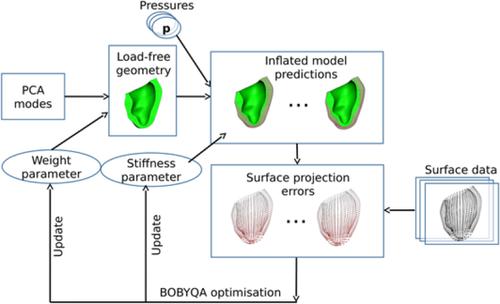当前位置:
X-MOL 学术
›
Int. J. Numer. Method. Biomed. Eng.
›
论文详情
Our official English website, www.x-mol.net, welcomes your feedback! (Note: you will need to create a separate account there.)
Efficient estimation of load-free left ventricular geometry and passive myocardial properties using principal component analysis.
International Journal for Numerical Methods in Biomedical Engineering ( IF 2.1 ) Pub Date : 2020-02-14 , DOI: 10.1002/cnm.3313 Zhinuo J Wang 1 , Vicky Y Wang 1 , Thiranja P Babarenda Gamage 1 , Vijayaraghavan Rajagopal 2 , J Jane Cao 3 , Poul M F Nielsen 1, 4 , Chris P Bradley 1 , Alistair A Young 1, 5 , Martyn P Nash 1, 4
International Journal for Numerical Methods in Biomedical Engineering ( IF 2.1 ) Pub Date : 2020-02-14 , DOI: 10.1002/cnm.3313 Zhinuo J Wang 1 , Vicky Y Wang 1 , Thiranja P Babarenda Gamage 1 , Vijayaraghavan Rajagopal 2 , J Jane Cao 3 , Poul M F Nielsen 1, 4 , Chris P Bradley 1 , Alistair A Young 1, 5 , Martyn P Nash 1, 4
Affiliation

|
Models of cardiac mechanics require a well‐defined reference geometry from which deformations and hence myocardial strain and stress can be calculated. In the in vivo beating heart, the load‐free (LF) geometry generally cannot be measured directly, since, in many cases, there is no stage at which the lumen pressures and contractile state are all zero. Therefore, there is a need for an efficient method to estimate the LF geometry, which is essential for an accurate mechanical simulation of left ventricular (LV) mechanics, and for estimations of passive and contractile constitutive parameters of the heart muscle. In this paper, we present a novel method for estimating both the LF geometry and the passive stiffness of the myocardium. A linear combination of principal components from a population of diastolic displacements is used to construct the LF geometry. For each estimate of the LF geometry and tissue stiffness, LV inflation is simulated, and the model predictions are compared with surface data at multiple stages during passive diastolic filling. The feasibility of this method was demonstrated using synthetically deformation data that were generated using LV models derived from clinical magnetic resonance image data, and the identifiability of the LF geometry and passive stiffness parameters were analysed using Hessian metrics. Applications of this method to clinical data would improve the accuracy of constitutive parameter estimation and allow a better simulation of LV wall strains and stresses.
中文翻译:

使用主成分分析可有效估算无负荷的左心室几何形状和被动心肌特性。
心脏力学模型需要定义明确的参考几何,从中可以计算变形,从而计算出心肌的应变和应力。在体内跳动的心脏中,通常无法直接测量无负荷(LF)的几何形状,因为在许多情况下,不存在管腔压力和收缩状态都为零的阶段。因此,需要一种有效的方法来估计LF几何形状,这对于左心室(LV)力学的精确机械仿真以及对心肌的被动和收缩本构参数的估计是必不可少的。在本文中,我们提出了一种新颖的方法来估计LF几何形状和心肌的被动刚度。舒张压位移的主要成分的线性组合用于构建LF几何形状。对于LF几何形状和组织刚度的每个估计,将模拟LV膨胀,并将模型预测值与被动舒张期充盈过程中多个阶段的表面数据进行比较。使用从临床磁共振图像数据得出的LV模型生成的合成变形数据证明了该方法的可行性,并使用Hessian度量分析了LF几何形状和被动刚度参数的可识别性。该方法在临床数据中的应用将提高本构参数估计的准确性,并允许更好地模拟左室壁的应变和应力。模拟左心室充盈,并在被动舒张期充盈过程中将模型预测与多个阶段的表面数据进行比较。使用从临床磁共振图像数据得出的LV模型生成的合成变形数据证明了该方法的可行性,并使用Hessian度量标准分析了LF几何形状和被动刚度参数的可识别性。该方法在临床数据中的应用将提高本构参数估计的准确性,并允许更好地模拟左室壁的应变和应力。模拟左心室充盈,并在被动舒张期充盈过程中将模型预测与多个阶段的表面数据进行比较。使用从临床磁共振图像数据得出的LV模型生成的合成变形数据证明了该方法的可行性,并使用Hessian度量分析了LF几何形状和被动刚度参数的可识别性。该方法在临床数据中的应用将提高本构参数估计的准确性,并允许更好地模拟左室壁的应变和应力。使用从临床磁共振图像数据得出的LV模型生成的合成变形数据证明了该方法的可行性,并使用Hessian度量分析了LF几何形状和被动刚度参数的可识别性。该方法在临床数据中的应用将提高本构参数估计的准确性,并允许更好地模拟左室壁的应变和应力。使用从临床磁共振图像数据得出的LV模型生成的合成变形数据证明了该方法的可行性,并使用Hessian度量分析了LF几何形状和被动刚度参数的可识别性。该方法在临床数据中的应用将提高本构参数估计的准确性,并可以更好地模拟左室壁的应变和应力。
更新日期:2020-02-14
中文翻译:

使用主成分分析可有效估算无负荷的左心室几何形状和被动心肌特性。
心脏力学模型需要定义明确的参考几何,从中可以计算变形,从而计算出心肌的应变和应力。在体内跳动的心脏中,通常无法直接测量无负荷(LF)的几何形状,因为在许多情况下,不存在管腔压力和收缩状态都为零的阶段。因此,需要一种有效的方法来估计LF几何形状,这对于左心室(LV)力学的精确机械仿真以及对心肌的被动和收缩本构参数的估计是必不可少的。在本文中,我们提出了一种新颖的方法来估计LF几何形状和心肌的被动刚度。舒张压位移的主要成分的线性组合用于构建LF几何形状。对于LF几何形状和组织刚度的每个估计,将模拟LV膨胀,并将模型预测值与被动舒张期充盈过程中多个阶段的表面数据进行比较。使用从临床磁共振图像数据得出的LV模型生成的合成变形数据证明了该方法的可行性,并使用Hessian度量分析了LF几何形状和被动刚度参数的可识别性。该方法在临床数据中的应用将提高本构参数估计的准确性,并允许更好地模拟左室壁的应变和应力。模拟左心室充盈,并在被动舒张期充盈过程中将模型预测与多个阶段的表面数据进行比较。使用从临床磁共振图像数据得出的LV模型生成的合成变形数据证明了该方法的可行性,并使用Hessian度量标准分析了LF几何形状和被动刚度参数的可识别性。该方法在临床数据中的应用将提高本构参数估计的准确性,并允许更好地模拟左室壁的应变和应力。模拟左心室充盈,并在被动舒张期充盈过程中将模型预测与多个阶段的表面数据进行比较。使用从临床磁共振图像数据得出的LV模型生成的合成变形数据证明了该方法的可行性,并使用Hessian度量分析了LF几何形状和被动刚度参数的可识别性。该方法在临床数据中的应用将提高本构参数估计的准确性,并允许更好地模拟左室壁的应变和应力。使用从临床磁共振图像数据得出的LV模型生成的合成变形数据证明了该方法的可行性,并使用Hessian度量分析了LF几何形状和被动刚度参数的可识别性。该方法在临床数据中的应用将提高本构参数估计的准确性,并允许更好地模拟左室壁的应变和应力。使用从临床磁共振图像数据得出的LV模型生成的合成变形数据证明了该方法的可行性,并使用Hessian度量分析了LF几何形状和被动刚度参数的可识别性。该方法在临床数据中的应用将提高本构参数估计的准确性,并可以更好地模拟左室壁的应变和应力。


























 京公网安备 11010802027423号
京公网安备 11010802027423号